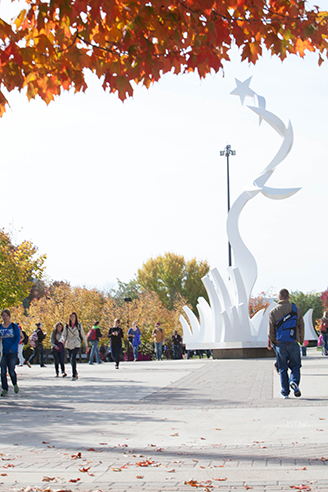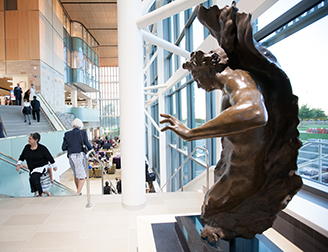Art at Grand Valley State University
Nathan Kemler, Curator of Collections Management
Art seems to me to be a state of soul more than anything else.
— Marc Chagall1
For over 50 years, Grand Valley has been collecting and displaying art around its growing campuses, now present in six different cities (Allendale, Grand Rapids, Muskegon, Holland, Traverse City, and Detroit). Many of these pieces have become uniquely ingrained into the GVSU experience. How many of us have referenced Cyril Lixenberg’s yellow steel Amaranth sculpture when giving directions to Mackinac Hall or walked through Gary Kulak’s soaring Transformational Link sculpture backwards during exam week for good luck? Dale Eldred’s kinetic pendulum sculpture has been a fixture on campus since 1973 and even has its own unofficial Twitter hashtag following (#GVSUWreckingBall), thanks to a recent Miley Cyrus song titled Wrecking Ball.
These artworks, and the rest of the GVSU collection of over 12,000 works of art, have different traditions and purposes; however, the real merit of the collection is that it promotes the idea of embracing art in order to improve one’s quality of life. It informs social discourse, encourages civic dialogue, fosters creative and critical thought, and provides avenues for personal reflection.
Stephen Weil, scholar emeritus at the Smithsonian Institution’s Center for Education and Museum Studies and deputy director of the Hirshhorn Museum and Sculpture Garden, aptly wrote in Making Museums Matter:
The good museum is neither a survival-driven institution nor a process-driven one. The good museum is a purpose-driven institution. The things that make a museum good are its purpose to make a positive difference in the quality of people’s lives …2
President Emeritus Arend D. Lubbers recognized this and expanded the collecting effort during his tenure with the purpose of creating a policy in which every building should be an art gallery. This goes against the very fabric of the traditional art museum world, one filled with controlled exhibition spaces, identified visitor expectations and very specific areas of subject expertise. This unconventional approach means that art at GVSU is everywhere. You will encounter work by alumni as you walk down the halls of the living centers, regional artwork from the Midwest on your way to class and international sculptures as you traverse the grounds. In total, over 8,000 works of art are displayed in public spaces throughout all GVSU buildings.
This unique format mirrors GVSU’s broader goal for seeking out innovative strategies to aid in meeting its mission of “educating students to shape their lives, their professions, and their societies. The university contributes to the enrichment of society through excellent teaching, active scholarship, and public service.” To solve global problems of poverty, chronic disease, human trafficking, and climate change, new creative solutions will need to be found and engaging with art directly assists in fostering these creative and critical thought processes.
The art at GVSU spans six different continents and are created with a myriad of different mediums and techniques. David Landes, Harvard Economic Historian, in The Wealth and Poverty of Nations: Why Some are Rich and Some So Poor, states:
… if we learn anything from the history of economic development, it is that culture makes all the difference. 3
In seeking this cultural understanding, GVSU has assembled a multicultural art collection that can be used for a multitude of interdisciplinary purposes. Music composition students have written original music influenced by the paintings created by German-American Grand Rapids regional painter Mathias Alten. Dance performances have been inspired by and choreographed from the Robert L. Hoskins and Erwin A. Raible Collection of Fin de Siécle French Prints. Poetry has been written about contemporary sculpture from the Netherlands. And graduate students from the School of Computing and Information Systems have developed mobile applications utilizing the entire art collection.
The 35 works of art comprising the exhibition Shared Passion: A Gift of the Stuart & Barbara Padnos Foundation Collection is, in essence, a microcosm of the GVSU art collection as a whole. It spans over 100 years and eight different countries. Themes range from a love of nature (Alvar Suñol Munoz-Ramos) and exploration of time and space (George J. Kafka) to social and political commentaries (Jack Levine) and the embrace of the fantastical, evocative and supernatural (Marc Chagall).
After the run of this exhibition, the collection will be dispersed throughout James H. Zumberge Hall for public display, indefinitely. It will be utilized for many interdisciplinary projects for future generations to come. The Shared Passion collection, as well as the rest of the 8,000+ works of art on view, serves as a window for the viewer into different cultures, historical movements, and social records. These avenues of understanding will ultimately reflect back, inform us, and improve our lives on a core level.

Amaranth

Transformational Link

Heaven and Earth

Ex Nihilo (Out of Nothing), Figure No. 8

References
- McMullen, Roy. The World of Marc Chagall. Garden City, N.Y.: Doubleday, 1968. Print.
- Weil, Stephen E. Making Museums Matter. Washington, D.C.: Smithsonian Institution Press, 2002. Print.
- Landes, David S. The Wealth and Poverty of Nations: Why Some are So Rich and Some So Poor. New York: W.W. Norton, 1998. Print.
